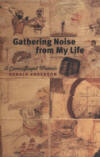Gathering Noise from My Life
In his author’s note at the beginning of his book, Donald Anderson writes: “I concern myself in this book with matters of war, race, religion, memory, illness, and family, sources of humor and horror. And: boxing, which has been reported in literature from Homer on.” This diverse list prepares the reader for the book’s numerous intersecting threads of themes and topics. Boxing stands alone here, because in addition to being a theme for rumination, its images of bobbing and weaving, punching and ducking describe the book’s structure. As the title suggests, this memoir is not a linear narrative but a chronological series of memories, quotes, and data, some related and some seemingly random, that trace the writer’s life from his birth in Butte, Montana in 1946 to his current life as director of the creative writing program at the U. S. Air Force Academy in Colorado.
In his author’s note at the beginning of his book, Donald Anderson writes: “I concern myself in this book with matters of war, race, religion, memory, illness, and family, sources of humor and horror. And: boxing, which has been reported in literature from Homer on.” This diverse list prepares the reader for the book’s numerous intersecting threads of themes and topics. Boxing stands alone here, because in addition to being a theme for rumination, its images of bobbing and weaving, punching and ducking describe the book’s structure. As the title suggests, this memoir is not a linear narrative but a chronological series of memories, quotes, and data, some related and some seemingly random, that trace the writer’s life from his birth in Butte, Montana in 1946 to his current life as director of the creative writing program at the U. S. Air Force Academy in Colorado.
Anderson also writes in the author’s note that, “We are where we’ve been and what we’ve read,” and the seven single-spaced pages of works cited at the end gives veracity to his latter claim. Among those he quotes are poets, philosophers, military leaders, soldiers, novelists, politicians, essayists, comedians, athletes, scientists. For the first chapter, the book’s structure made it seem inaccessible to me, like a disjointed gathering of unrelated ideas, memories, and facts. For example, Anderson follows up a paragraph about the daredevil Evel Knievel with one about his high school gym teacher, a World War I U. S. Navy veteran and World War II U. S. Army PE instructor, who seemingly have no connection to each other. But I soon realized that this technique provides a window into Anderson’s mind, as well as his life. For example, Anderson reveals that the worst disaster in U. S. mining history took place in his hometown of Butte in 1917, when 168 men died after a fire that began in the mine ignited twelve cases of dynamite. He ends this paragraph: “In a more recent explosion, 168 people died at the hand of Timothy McVeigh when he bombed the Alfred P. Murrah Federal Building in Oklahoma City, Oklahoma.” Explosions and the number of dead provide the connective thread between the mine accident and McVeigh’s act of violence. Using this technique throughout the book, Anderson skillfully connects memories, thoughts, ideas, poems, book quotes, graffiti, statistics, and cultural and historical trivia to portray the life and mind of the writer, who grew up in a mining community, worked in the mines, spent two years in France as a Mormon missionary, and retired as a Colonel after twenty-two years in the U. S. Air Force, all of which led him to his current vocation of teaching.
Although Anderson speaks from a position of authority on many topics, he writes with empathy and humility, as when he proposes, “What are we but history with a small h in history with a big H?” As readers would perhaps expect of a book written by a career military officer, Anderson frequently ruminates on war and its impact on history and society. He includes excerpts from biographies on political and military leaders, testimony from court hearings and trials, statistics about casualties and damages. In one sobering statistic about the Vietnam War he writes, “May we remember that in addition to our losses—200,000 wounded, 58,000 dead—the Vietnamese suffered up to 2 million wounded and 3 million dead.” He also notes that “fewer people died at Pearl Harbor than at Ground Zero.” Anderson provides stark commentaries on our culture, as well as on war: “As of 2010, seven times the number of American dead in Iraq and Afghanistan have died in Mexico in its drug wars.”
As serious and somber as much of Anderson’s writing is in this book, he also frequently reveals his sense of humor. He writes, “One Notion of Hell: You’re duct-taped to a tree, forced to listen to Debbie Boone sing ‘You Light Up My Life’ forever” and “When you purchase your third clothes dryer, you’ve probably purchased your last. Think about it.” A brief summation of a section near the end of the book might describe a series of paragraphs, varying in length from five words to several sentences, ranging in topics from interior design to mathematical equations to the private lives of celebrities to family history to botany, but in order to understand how Anderson melds these diverse themes into a cohesive whole, the reader must explore this book for her/himself. Think of the boxer: bouncing, swaying, jabbing, feinting, weaving, punching, connecting blows that strike the reader’s mind and heart, leaving scars and questions that will linger long after the final page is turned.





